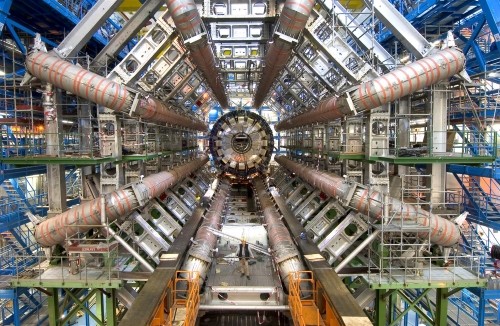Tag archives: ATLAS
‘New boson’ buzz intensifies at CERN, fire prevention in space and Neil Turok on a bright future for physics

ATLAS under construction: has the experiment gone beyond the Standard Model? (Courtesy: ATLAS)
By Hamish Johnston
Excitement levels in the world of particle physics hit the roof this week as further evidence emerged that physicists working on the Large Hadron Collider (LHC) may have caught sight of a new particle that is not described by the Standard Model of particle physics. If this turns out to be true, it will be the most profound discovery in particle physics in decades and would surely lead to a Nobel prize.
View all posts by this author | View this author's profile
Playing the cosmic piano
By James Dacey
Researchers at CERN are renowned for their musical side-projects. Notable examples include the album released by scientists at the ATLAS detector in 2010, and the “Large hadron rap“, which currently has almost 8 million hits on YouTube. And of course don’t forget the pop-star-turned-physicist Brian Cox who had the UK chart-topping hit “Things can only get better” in the 1990s with his band D:Ream.
Following in this musical tradition, a duo of Mexican researchers has invented a “Cosmic Piano” inspired by the technologies used at the ALICE particle detector at the Large Hadron Collider (LHC). The instrument’s inventors Arturo Fernández Téllez and Guillermo Tejeda Muñoz hold positions at CERN and the University of Puebla in Mexico. They hope the device can demonstrate both the science and the art of the work being carried out at particle-physics facilities.
View all posts by this author | View this author's profile
CDF bump almost gets a five-star rating

The graph shows the distribution of the “w-jj excess” as seen by the CDF experiment (Courtesy: Punzi/Fermilab)
By Tushna Commissariat
Two months ago, in early April, the particle-physics community was rife with speculation and excitement over a “bump” – a possible new particle – in the data that Fermilab’s CDF experiment was looking at. On Monday 30 May Giovanni Punzi, a CDF collaborator, presented an update on what is now referred to the “ W-jj” bump, as a part of his talk at the 23rd Rencontres de Blois Particle Physics and Cosmology conference currently being held in France. The update says that the bump is seen in more recent data with an even larger statistical significance.
At the time, CDF was looking for slightly rare di-boson pairs – W bosons produced in association with another W or a Z boson. It noted a bump between 120 and 160 GeV /C2 in the jets produced in the collisions with a statistical significance of about “three-sigma”, which meant that the result would not be considered valuable until a “five-sigma” statistical significance could be established. The new data, however, have established a significance that is officially “closer to five sigma” (unconfirmed sources suggest it is as close as 4.8) and that “it was not just a statistical fluctuation” and that it is now a “serious issue for CDF to understand this”, according to Punzi.
Interestingly, Punzi’s slides also say that it is almost impossible that bump is due to the Standard Model top-quark background, as suggested by some theoretical papers, as that would imply that previous measurements for SM top-quark background had huge errors. The next step forward would be if CDF’s sister experiment D0 or the LHC’s ATLAS or CMS experiments, none of which have found the bump in their data so far, manage to detect it.
This updated result has seen a variety of responses from physicists.
Adam Falkowski, who writes the Resonaances blog, seems rather jubilant. “In a collider experiment, such a huge departure from a Standard Model prediction is happening for the first time in the human history,” he writes. “I don’t have to stress how exciting it is.”
Peter Woit, author of the Not Even Wrong blog, feels that while a five-sigma significance is important, problems with background modelling might thwart the result. “The signal is being extracted from a huge background, so a small misunderstanding of the background could be its cause.” Only a detection of the same result by another experiment would make the case more compelling, according to him.
Tommaso Dorigo, a blogger and CDF collaborator, is still sceptical of the result and chalks it up to bad background modelling, like Woit. “No, it is not the Higgs. And it is not a new particle. It is, in my humble opinion, a problem in the modelling of backgrounds, one which was unnoticed before only because it is small enough to have escaped previous attempts at “tuning” the simulations.”, he writes in his blog.
So while it seems like we the path to “new physics” is full of “bumps”, the field of particle physics is a rather exciting one right now! Take a look at the slides Punzi used for his talk here.
View all posts by this author | View this author's profile